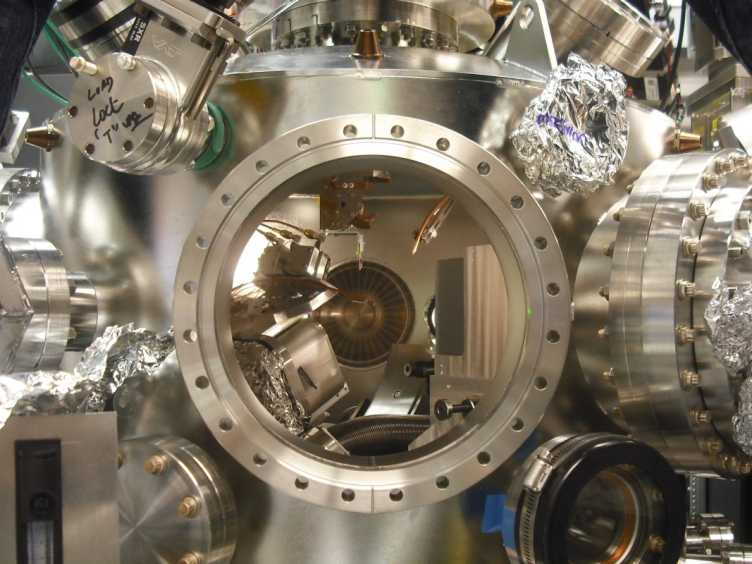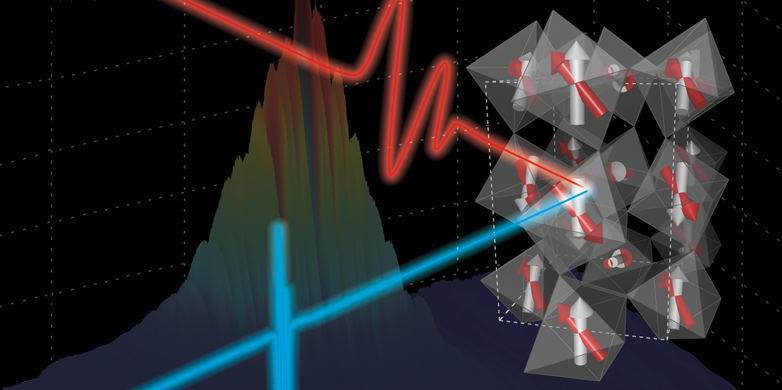Modifying magnetic properties with electricity
Scientists from ETH Zurich and PSI have found evidence that the magnetic properties of particular materials can be modified extremely quickly. This offers a glimmer of hope that it will be possible to produce ultra-fast computer hard drives from such materials in the future.
In most materials, magnetic order, can be redirected only by applying an external magnetic field. In the case of a special class of materials, however – multiferroics – there is a second option: their magnetic properties can be changed by an applied voltage. Multiferroics are currently the subject of intense research in physics, an interest which stems from possible future uses in computer storage media. In today’s devices data is currently written onto a computer’s hard drive using a mechanical magnetic head, but in the future multiferroic hard drives could be inscribed electrically at a much faster rate.
Before we reach that stage, however, we still have a long way to go. For the moment, only the basic physical properties of this relatively new class of materials are being studied. Until now, there has been no experimental evidence that the magnetic order of multiferroics can be changed quickly enough to compete with the hard drives of today. “The fastest measured change using electric field was in the thousandths-of-a-second range,” says Teresa Kubacka, a doctoral student in the group led by ETH-Zurich professor Steven Johnson. By way of comparison: using a magnetic head, data can already be saved on a hard drive a million times faster.
In an international team of researchers lead by scientists from ETH Zurich and the Paul Scherrer Institute (PSI), however, Kubacka has now found experimental evidence that the ordering of the magnetic moments in multiferroics can also respond much more quickly to voltage – in less than a billionth of a second, i.e. one thousand times faster than the speed at which data can be written on a hard drive today.
Magnetic moments turn easily

Specifically, the scientists studied the material terbium manganite. Its multiferroic properties were only discovered around a decade ago and since then physicists have used it as a model material for better understanding multiferroic properties. In measurements made with a free-electron laser (see box) at Stanford, California, the researchers from Switzerland demonstrated that the magnetic moments in a millimeter-sized crystal of this material change direction within 200 femtoseconds after a particular electrical excitation. “Although other scientists had already studied multiferroics, this was the first time that we saw magnetic moments reacting so quickly to applied electric field,” says Kubacka.
In the experiment, the magnetic moments of terbium manganite “only” turned four degrees instead of the full 180 degrees, which would be interesting for potential applications. For the electric fields used to excite the material in the experiment, however, this echoes the predictions a group of theoretical physicists from Japan had made beforehand. The researchers from ETH Zurich and PSI thus partly confirm the theory, which also predicts that is it possible to completely reverse the direction of the magnetic moments – by 180 degrees – if the electric field is strong enough. Although no research facility is able to generate electric fields that are strong enough today, Kubacka finds the results encouraging. “From today’s perspective, at least it doesn’t seem impossible that we will be able to completely reverse the magnetic moments of multiferroic materials at an ultra-fast speed one day,” she says.
Cooling necessary
However, it is highly unlikely that applications such as data storage will ever be realised with the model material terbium manganite, the researcher stresses, as it only displays its multiferroic properties at temperatures lower than minus 246 degrees Celsius. Although the researchers were able to cool the material to these temperatures in their experiments, multiferroic materials that also exhibit these properties at room temperature would be advantageous for widespread applications. At least one such material is already known.
Making rapid processes visible at high resolution
A free-electron laser (FEL) is a radiation source that can be used to generate so-called synchrotron x-rays with laser properties. Because synchrotron x-radiation has a very short wavelength, tiny structures the size of an atom can be rendered visible. Classic synchrotron x-rays, however, can only be generated in comparatively long pulses. Using laser technology, extremely short light pulses can be generated, although conventional optical lasers have the disadvantage that they can generate only long-wavelength light. In the case of FELs, the advantages of synchrotron x-radiation and lasers are combined, enabling ultra-fast processes to be rendered visible at a high spatial and temporal resolution (ten trillionths of a second).
FELs are large-scale research facilities. There are currently only four in the world, the largest of which is located at Stanford University in the USA, where the aforementioned research project was conducted. The external page SwissFEL facility currently under construction at the Paul Scherrer Institute is expected to commence operations in 2016 and facilitate measurements at a similar high spatial and temporal resolution.
Literature reference
Kubacka T et al.: Large amplitude spin dynamics driven by a THz pulse in resonance with an electromagnon. Science, Advance online publication 6 March 2014, doi: external page 10.1126/science.1242862

Comments
No comments yet